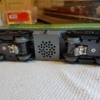I recently worked on a set of 4 beautiful brass N-scale Santa Fe F7s (2 AB sets, Key Imports IIRC). Each loco had one axle (or maybe 2 axles?) with traction tires on both wheels. Also included in the boxes were extra axles with no traction tires on the wheels. Being brass to start with, and including traction tires, there shouldn't be any shortage of pulling power here!
Test running each loco individually, they seemed to run alright. Although they sometimes derailed when going through a switch, and sometime on a curve. Hooking them all together into a gorgeous Santa Fe A-B-B-A set, they really ran like cr@p. Herky-jerky, derail for no reason, they just didn't seem to work or play well together. One thing I had noticed, one loco ran slightly faster than 2 of them. The 2 ran about the same speed. A fourth loco ran slightly slower than the 2.
I've had a theory about traction tires for a long time. After re-configuring the consist based on my theory, it was a whole new story. They ran absolutely beautifully together. Like a well-trained set of top-notch, thoroughbred chariot horses. Smooth, powerful, absolutely no derailing or jerkiness or any other distasteful characteristics. It was the difference between night and day!
I pretty sure my theory would work in EVERY scale, not just N-scale. 
Well, okay, while this topic is probably getting close to being beaten to death, I did promise to elaborate on my original post. Probably best I took a short sabbatical however, because it has given me time to think a little more about my theory, and perhaps modify it somewhat.
On the 4 brass N-scale locos, not only did they come with the extra, non-traction tire wheel sets, it also ended being fairly straightforward to pull individual wheels from the axles and press them back on. Since I know the owner was always going to run them as an A-B-B-A consist, I ended up equipping ONE unit with ONE traction tire on ONE side only of ONE truck only. In other words, out of 32 total wheels on the consist, I ended up with ONE traction tire wheel and 31 standard wheels.
That was my theory for taking care of two distinct problems with the consist. One problem fixed was the fact that the slightly faster and the slightly slower locomotive wheels could "slip & slide" so to speak on the rails, instead of binding up like they did when all locos had traction tires.
The other problem fixed was one that nobody really thinks about very much, or how is a powered wheel set with a solid axle and traction tires on both wheels supposed to go around curved trackage without having a differential to allow the wheels to rotate at different speeds? Extreme example: You would't want to try drive your car or truck on the road with a solid axle, would you? It would be fine until the first time you had to turn. Same thing with our little trains. I'm sure they struggle in a miniature sort of ways themselves. By having a traction tire on one wheel only, it provides most of the traction, while the other standard metal wheel with a lot less adhesion can slowly slip on the rail as needed while the solid axle wheel set rolls along the curved trackage.
I think HO and N have gotten away from traction tires in the past couple of decades more so due to their smaller scale factor. They can have both reasonable grades and reasonable curves in smaller spaces than O-scale can have. Take for instance, the good ol' 4 x 8 sheet of plywood. You can easily build an N-scale layout on with super-generous curve radii and up & over track work with 2 ~ 2½% grades. For HO scale, grades and curves not quite as good, but still plausible. But basically, they can emulate their full-sized brethren fairly closely in this limited space.
For O-gauge, forget it. It's pretty much toy train city all the way, complete with sharp curves, traction tires, and steep grades. Unless of course, you have an entire floor of your house or a big barn/metal building to construct a layout in. Unfortunately, the biggest majority of O-gaugers do NOT have that kind of room to spare, so steep grades, sharp curves, and traction tires will probably always be a mainstay for this scale.
Soooo................. how can we apply all of this nonsense to O-gauge/O-scale? For the final step, we need to put our heads together in a good, logical orderly fashion just like the 3 Stooges would (complete with 3 Stooges sound effects) and come up with a plan. Unfortunately I have to head in to work shortly, so I will have to close for now and continue this in the next session, hopefully in the next day or two........................






